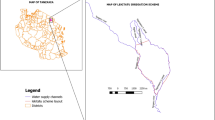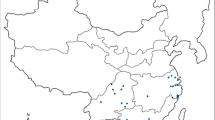Abstract
SRI practices can usually increase the yield of paddy without using special varieties of rice or chemicals. High yield of paddy can be simply achieved through the combination of transplanting single seedlings about 8–10 days old with just two leaves on 40 cm × 40 cm spacing, providing organic fertilizer, and intermittent irrigation. No pesticides are applied. Historically, integrated management of water and crop (particularly rice) in the Philippines, had its beginning with the Spaniards, but more formal events were recorded in the 1950s by Margate (1954) in “Rice: 100 Cavans (50 kg/cavan) per Hectare.” This was followed by the Water Management Manual released in the 1970s by the Asian Development Bank (ADB) and National Irrigation Administration (NIA). Recently, the Southern Philippines Irrigation Sector Project (SPISP), a joint ADB–NIA effort, has commenced trials with the system of rice intensification (SRI) practice. One of the most specific features of SRI is the intermittent irrigation system which requires assured water supply at necessary timing. It is easier to attain assured water supply on timely manner through irrigation management transfer (IMT) which encourages the empowerment of fair water distribution. This article analyzes the merit of IMT for SRI.

Similar content being viewed by others
References
Asian Development Bank (1973) Appendix 1. The NIA-ADB Water Management Project. In: Regional workshop on irrigation water management
Asian Development Bank (2004) Philippines: Irrigation Sector Project (IMT) survey report
Basiao (2006) Oral communication on the situation of SRI in Kabankalan City, Philippines
Margate E (1954) In Erasmo IM (ed) Ang Humay 100 Kabanes Matag Hektarea (Rice: 100 cavans per hectare). Electro-Real Enterprise, Publisher & Distributor, Dipolog, Zamboanga del Norte
National Irrigation Administration (1970) Manual on irrigation water management. NIA-ADB Water Management Project
National Irrigation Administration (2004, 2005, 2006) Field SRI trial data provided by NIA
Patrocinio (2006) Oral communication during the Project implementation
Rosales (2006) Oral communication during the Project review
Rickman JF (2002) Preliminary results: rice production and the system of rice intensification (SRI). IRRI, Philippines
Salazar C (2006) Oral communication on the yield of his own plot and water consumption, Philippines
Uphoff N (2006) Oral communication during the SRI seminar, Philippines
Author information
Authors and Affiliations
Corresponding author
Additional information
The views expressed in this article are the views of the author and do not necessarily reflect the views of ADB.
Rights and permissions
About this article
Cite this article
Miyazato, T., Mohammed, R.A. & Lazaro, R.C. Irrigation management transfer (IMT) and system of rice intensification (SRI) practice in the Philippines. Paddy Water Environ 8, 91–97 (2010). https://doi.org/10.1007/s10333-009-0188-4
Received:
Accepted:
Published:
Issue Date:
DOI: https://doi.org/10.1007/s10333-009-0188-4




